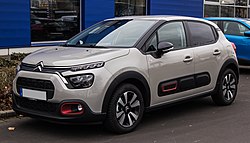Top Qs
Timeline
Chat
Perspective
PSA PF1 platform
Automobile platform by PSA Peugeot Citroën From Wikipedia, the free encyclopedia
Remove ads
The PSA PF1 platform is a global subcompact automobile platform originally developed by the French automaker PSA, now Stellantis. It has been the foundation for a wide range of B-segment (subcompact) cars produced since the early 2000s.[1]
This article's lead section may be too short to adequately summarize the key points. (November 2024) |
Remove ads
Overview
The PF1 platform was designed to underpin small cars, offering flexibility to support various body styles such as hatchbacks, sedans, crossovers, and small vans. Its layout typically features a transverse front-engine, front-wheel-drive configuration, though some derivatives were engineered with all-wheel drive.[2]
While PF1 was primarily used for passenger vehicles, it also served as the basis for light commercial vehicles (LCVs), reflecting PSA’s strategy of maximizing economies of scale.[3]
Remove ads
Applications
Vehicles based on the PF1 platform include several popular models across the Peugeot, Citroën, DS, Opel, and Vauxhall brands. Notable examples include:[4]
- Peugeot 206+ and Peugeot 207
- Peugeot 208 (first generation)
- Peugeot 2008 (first generation)
- Citroën C3 (second and third generations)
- Citroën C3 Aircross (first generation)
- Citroën DS 3
This widespread adoption made PF1 one of PSA’s most commercially important architectures for over a decade.[5]
Remove ads
Successor platforms
As automotive technology and regulatory requirements evolved, PF1 began to be phased out in favor of more modern and modular architectures. Its direct successor is the CMP (Common Modular Platform), co-developed by PSA and the Chinese manufacturer Dongfeng.[6] CMP supports both internal combustion engine (ICE) and electric powertrains (eCMP), enabling Stellantis brands to transition into electrification.
Larger PSA models during the PF1 era were based on the PF2 and PF3 platforms, covering compact and mid-size segments respectively.[3]
Legacy
The PF1 platform played a significant role in establishing PSA’s presence in key global markets, especially in Europe, South America, and select Asian regions. Its derivatives helped Peugeot and Citroën maintain strong positions in the subcompact market, a vital segment in terms of sales volume.[7]
Models
Summarize
Perspective
Vehicles based on the PF1 platform:
- 1998–2013 Peugeot 206/206+, essentially a combination of the 106/Saxo/AX and the PF1 platform
- 2002–2009 Citroën C3 I[8]
- 2003–2012 Citroën C3 Pluriel
- 2003–2009 Citroën C2
- 2005–2009 Peugeot 1007
- 2006–2014 Peugeot 207
- 2009–2021 Citroën C3 II[9]
- 2009–2017 Citroën C3 Picasso
- 2010–present IKCO Runna, essentially a combination of the 106/Saxo and the PF1 platform
- 2010–2021 Citroën C3 Aircross/C3 Picasso/Aircross (Latin America)
- 2010–2019 Citroën DS3
- 2012–2020 Peugeot 208 I
- 2013–2019 Peugeot 2008 I
- 2012–2021 Peugeot 301
- 2012–2022 Citroën C-Elysée/Dongfeng Junfeng EV30/Dongfeng Fukang e-Elysée
- 2014–2020 Citroën C4 Cactus[10]
- 2014–2023 Citroën C3-XR/C3L
- 2016–2024 Citroën C3 III - platform renamed to 'Platform A' for media coverage [11][12]
- 2017–2024 Opel/Vauxhall Crossland
- 2017–2024 Citroën C3 Aircross I
- 2021–present IKCO Tara
- Peugeot 206/206+
- Citroën C3 I
- Citroën C3 Pluriel
- Citroën C2
- Peugeot 1007
- Peugeot 207
- Citroën C3 II
- Citroën C3 Picasso
- IKCO Runna
- Citroën C3 Aircross/C3 Picasso/Aircross
- Citroën DS 3
- Peugeot 208 I
- Peugeot 2008 I
- Peugeot 301
- Citroën C-Elysée
- Citroën C4 Cactus
- Citroën C3-XR
- Citroën C3L
- Citroën C3 III
- Opel/Vauxhall Crossland
- Citroën C3 Aircross I
- IKCO Tara
Remove ads
See also
References
Wikiwand - on
Seamless Wikipedia browsing. On steroids.
Remove ads





















